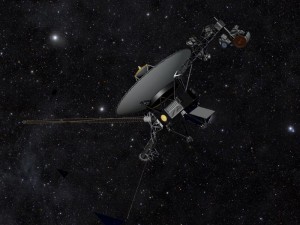16 August 2013
Is Voyager 1 In Interstellar Space?? The Debate Heats Up
Posted by Dan Satterfield
 NASA Voyager Statement about Competing Models to Explain Recent Spacecraft Data
NASA Voyager Statement about Competing Models to Explain Recent Spacecraft Data
A newly published paper argues that NASA’s Voyager 1 spacecraft has already entered interstellar space. The model described in the paper is new and different from other models used so far to explain the data the spacecraft has been sending back from more than 11 billion miles (18 billion kilometers) away from our sun.
NASA’s Voyager project scientist, Ed Stone of the California Institute of Technology in Pasadena, explains:
“Details of a new model have just been published that lead the scientists who created the model to argue that NASA’s Voyager 1 spacecraft data can be consistent with entering interstellar space in 2012. In describing on a fine scale how magnetic field lines from the sun and magnetic field lines from interstellar space can connect to each other, they conclude Voyager 1 has been detecting the interstellar magnetic field since July 27, 2012. Their model would mean that the interstellar magnetic field direction is the same as that which originates from our sun.
Other models envision the interstellar magnetic field draped around our solar bubble and predict that the direction of the interstellar magnetic field is different from the solar magnetic field inside. By that interpretation, Voyager 1 would still be inside our solar bubble.
The fine-scale magnetic connection model will become part of the discussion among scientists as they try to reconcile what may be happening on a fine scale with what happens on a larger scale.
The Voyager 1 spacecraft is exploring a region no spacecraft has ever been to before. We will continue to look for any further developments over the coming months and years as Voyager explores an uncharted frontier.”
How far away is Voyager 1? It’s now 17 light hours from Earth. It takes 34 hours to send a command and then hear back from Voyager that it received it. Take a meter stick and put a ball down on the ground. At one meter put a small seed down for the Earth. Jupiter is a marble at 5 meters, and the farthest planet is Neptune at 40 meters. Voyager 1 is at 125 meters. It takes light about 8 minutes to travel each meter in your home-made solar system.


 Dan Satterfield has worked as an on air meteorologist for 32 years in Oklahoma, Florida and Alabama. Forecasting weather is Dan's job, but all of Earth Science is his passion. This journal is where Dan writes about things he has too little time for on air. Dan blogs about peer-reviewed Earth science for Junior High level audiences and up.
Dan Satterfield has worked as an on air meteorologist for 32 years in Oklahoma, Florida and Alabama. Forecasting weather is Dan's job, but all of Earth Science is his passion. This journal is where Dan writes about things he has too little time for on air. Dan blogs about peer-reviewed Earth science for Junior High level audiences and up.